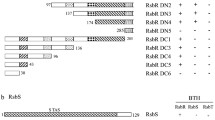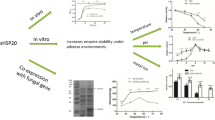Abstract
The small heat shock protein Hsp21 of Clostridium acetobutylicum was recently identified as a rubrerythrin-like protein with a rubredoxin-like FeS4 domain at the N-terminus and a ferritin-like diiron domain at the C-terminus. Here, we report that the two identical tandem genes rbr3A and rbr3B, which encode the heat shock protein Hsp21, show the transcription pattern of general stress genes. Northern blot analysis indicated that the transcription of the rbr3AB operon is induced by various environmental stress conditions: in addition to heat and oxidative stress, an increase of the pH of the growth medium from 4.5 to 6.2, addition of the salt NaCl (400 mM) or of the solvent butanol (3.5% v/v), and lowering the incubation temperature from 37 to 25°C resulted in transiently increased transcript levels. The promoter region deduced from the 5′ end of the mRNA has only limited similarity to the consensus promoter sequence of Gram-positive bacteria. A conserved inverted repeat between this promoter and the initiation codon is proposed to have a regulatory role. Although C. acetobutylicum is regarded as a strictly anaerobic bacterium, live/dead staining demonstrated that it can survive exposure to air or H2O2 and other stressors to various extents.





Similar content being viewed by others
References
Alsaker KV, Papoutsakis ET (2005) Transcriptional program of early sporulation and stationary-phase events in Clostridium acetobutylicum. J Bacteriol 187:7103–7118
Bahl H, Gottschalk G (1984) Parameters affecting solvent production by Clostridium acetobutylicum in continuous culture. Biotechnol Bioeng Symp 14:215–223
Bahl H, Andersch W, Gottschalk G (1982) Continuous production of acetone and butanol by Clostridium acetobutylicum grown in a two-stage phosphate limited chemostat. Eur J Appl Microbiol Biotechnol 15:201–205
Bahl H, Gottwald M, Kuhn A, Rale V, Andersch W, Gottschalk G (1986) Nutritional factors affecting the ratio of solvents produced by Clostridium acetobutylicum. Appl Environ Microbiol 52:169–172
Bahl H, Müller H, Behrens S, Joseph H, Narberhaus F (1995) Expression of heat shock genes in Clostridium acetobutylicum. FEMS Microbiol Rev 17:341–348
Bonomi F, Kurtz DM Jr, Cui X (1996) Ferroxidase activity of recombinant Desulfovibrio vulgaris rubrerythrin. J Biol Inorg Chem 1:67–72
Chan PF, Foster SJ, Ingham E, Clements MO (1998) The Staphylococcus aureus alternative sigma factor σB controls the environmental stress response but not starvation survival or pathogenicity in a mouse abscess model. J Bacteriol 180:6082–6089
Coulter ED, Shenvi NV, Kurtz DM Jr (1999) NADH peroxidase activity of rubrerythrin. Biophys Res Commun 255:317–323
deMaré F, Kurtz DM Jr, Nordlund P (1996) The structure of Desulfovibrio vulgaris rubrerythrin reveals a unique combination of rubredoxin-like FeS4 and ferritin-like diiron domains. Nat Struct Biol 3:539–546
Dürre P, Bahl H (1996) Microbial production of acetone/butanol/isopropanol. In: Rehm HJ, Reed G, Pühler A, Stadler P (eds) Biotechnology: a multi-volume comprehensive treatise, vol 1, 2nd edn. VCH Verlagsgesellschaft, Weinheim, pp 229–268
Ferreira A, O’Byrne CP, Boor KJ (2001) Role of σB in heat, ethanol, acid, and oxidative stress resistance and during carbon starvation in Listeria monocytogenes. Appl Environ Microbiol 67:4454–4457
Fournier M, Aubert C, Dermoun Z, Durand MC, Moinier D, Dolla A (2006) Response of the anaerobe Desulfovibrio vulgaris Hildenborough to oxidative conditions: proteome and transcript analysis. Biochimie 88:85–94
Geer LY, Domrachev M, Lipman DJ, Bryant SH (2002) CDART: protein homology by domain architecture. Genome Res 12:1619–1623
Geissmann TA, Teuber M, Meile L (1999) Transcriptional analysis of the rubrerythrin and superoxide dismutase genes of Clostridium perfringens. J Bacteriol 181:7136–7139
Hecker M, Völker U (2001) General stress response of Bacillus subtilis and other bacteria. Adv Microb Physiol 44:35–91
Kawasaki S, Ishikura J, Watamura Y, Ono M, Niimura Y (2004) Identification of O2-induced peptides in the obligatory anaerobe, Clostridium acetobutylicum. FEBS Lett 571:21–25
Kellmann JW, Pichersky E, Piechulla B (1990) Analysis of the diurnal expression patterns of the tomato chlorophyll a/b binding protein genes. Influence of light and characterization of the gene family. Photochem Photobiol 52:35–41
Lumppio HL, Shenvi NV, Summers AO, Voordouw G, Kurtz DM Jr (2001) Rubrerythrin and rubredoxin oxidoreductase in Desulfovibrio vulgaris: a novel oxidative stress protection system. J Bacteriol 183:101–108
Mani N, Dupuy B (2001) Regulation of toxin synthesis in Clostridium difficile by an alternative RNA polymerase sigma factor. Proc Natl Acad Sci USA 98:5844–5849
Mani N, Lyras D, Barroso L, Howarth P, Wilkins T, Rood JI, Sonenshine AL, Dupuy B (2002) Environmental response and autoregulation of Clostridium difficile TxeR, a sigma factor for toxin gene expression. J Bacteriol 184:5971–5978
May A, Hillmann F, Riebe O, Fischer RJ, Bahl H (2004) A rubrerythrin-like oxidative stress protein of C. acetobutylicum is encoded by a duplicated gene and identical to heat shock protein Hsp21. FEMS Microbiol Lett 238:249–254
Moncrief JS, Barroso LA, Wilkins TD (1997) Positive regulation of Clostridium difficile toxins. Infect Immun 65:1105–1108
Narberhaus F, Bahl H (1992) Cloning, sequencing, and molecular analysis of the groESL operon of Clostridium acetobutylicum. J Bacteriol 174:3282–3289
Nölling J, Breton G, Omelchenko MV, Makarova KS, Zeng Q, Gibson R, Mei Lee H, Dubois J, Qiu D, Hitti J, GTC Sequencing Center Production, Finishing, and Bioinformatics Team, Wolf YI, Tatusov RL, Sabathe F, Doucette-Stamm L, Soucaille P, Daly MJ, Bennett GN, Koonin EV, Smith DR (2001) Genome sequence and comparative analysis of the solvent-producing bacterium Clostridium acetobutylicum. J Bacteriol 183:4823–4838
O’Brien RW, Morris JG (1971) Oxygen and the growth and metabolism of Clostridium acetobutylicum. J Gen Microbiol 68:307–318
Pich A, Narberhaus F, Bahl H (1990) Induction of heat shock proteins during initiation of solvent formation in Clostridium acetobutylicum. Appl Microbiol Biotechnol 33:697–704
Sonenshein AL, Haraldsen JD, Dupuy B (2005) RNA-polymerases and alternative σ-factors. In: Dürre P (ed) Handbook on Clostridia. CRC Press, Boca Raton, pp 607–630
Storz G, Hengge-Aronis R (2000) Bacterial stress responses. ASM Press, Washington
Sztukowska M, Bugno M, Potempa J, Travis J, Kurtz DM Jr (2002) Role of rubrerythrin in the oxidative stress response of Porphyromonas gingivalis. Mol Microbiol 44:479–488
Weinberg MV, Jenney FE Jr, Cui X, Adams MWW (2004) Rubrerythrin from the hyperthermopilic archaeon Pyrococcus furiosus is a rubredoxin-dependent, iron-containing peroxidase. J Bacteriol 186:7888–7895
Young M, Minton NP, Staudenbauer WL (1989) Recent advances in the genetics of the clostridia. FEMS Microbiol Rev 63:301–326
Zuker M (2003) Mfold web server for nucleic acid folding and hybridization prediction. Nucleic Acids Res 31:3406–3415
Acknowledgements
We thank Rhena Schumann for providing assistance in fluorescence imaging.
Author information
Authors and Affiliations
Corresponding author
Rights and permissions
About this article
Cite this article
Hillmann, F., Fischer, RJ. & Bahl, H. The rubrerythrin-like protein Hsp21 of Clostridium acetobutylicum is a general stress protein. Arch Microbiol 185, 270–276 (2006). https://doi.org/10.1007/s00203-006-0091-y
Received:
Revised:
Accepted:
Published:
Issue Date:
DOI: https://doi.org/10.1007/s00203-006-0091-y




